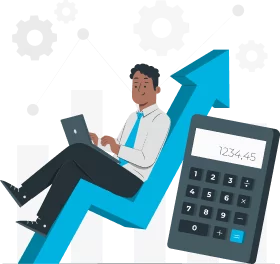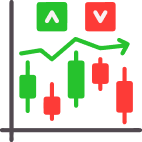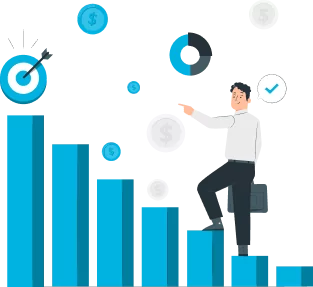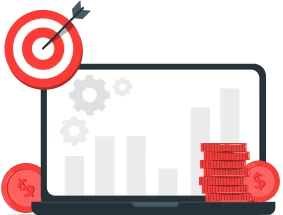Input a number into the box to see how the current risk parameters of the trade are affected with leverage. With leverage you can take a larger position size, but that means our stop loss must move closer to the entry so that we don't risk more than the desired % or $ amount of our account (Account Risk above).
Inputting 10 into the box means the original position size calculated above is multiplied by 10.
Leverage increases the buying power of the capital in your account. 10:1 leverage means you can make trades with a value 10x the capital in your account. 100;1 means your capital is magnified 100 times. For example, if you have $10,000 in the account and 50:1 leverage, you can purchase up to $500,000 in positions. Trading on leverage allows for larger position sizes which can increase both profits and losses on trades.

Position size is key to unlocking the most potential out of your trading. It determines how much of your bankroll you’re risking on every trade and finds the perfect spot between your bankroll, stop loss, and risk tolerance.
That’s exactly why this position size calculator is your new best friend moving forward. Regardless of what asset you’re trading, it helps you zero in on the correct trading size based on your total bankroll, the price of the asset, your stop loss, and how much of your bankroll you’re willing to risk on any given trade.
Without a position size calculator forex, you could easily overleverage your account or take on overly risky positions. But with our tool, you put yourself right in the driver’s seat. You’ll know exactly what you’re doing and keep a tight rein on your risk exposure. Decide how much risk you wish to take on, and our crypto and stock position size calculator does all the work for you as it adjusts your position size based on cold hard numbers.
There isn’t a single bulletproof trading strategy that wins each time you use it. If you’re out there looking for a moonshot while risking too much on the line, a couple of bad trades could decimate your bankroll in a heartbeat.
On the other hand, if you risk too little, you’re just leaving money on the table, and that’s a waste. That’s where our position size calculator stocks comes in. Think of it as your trading roadmap telling you exactly how much you should risk based on your trade levels, bankroll/account size, and risk profile. It allows you to see how different market scenarios can affect your profits and losses, so you’re never in the dark about the what-ifs and hypothetical scenarios.

These buttons enable you to buy assets. If you’re buying a particular asset, select “long.” If you intend to profit from the price of the asset declining or shorting it, select “short.”

The entry price is the price at which you are buying the underlying asset.





Risk size calculation refers to the dollar amount being risked expressed by the following equation: Account Risk % x Account Size, or the dollar amount in the Account Risk $ box. This represents the dollar amount being risked on the particular trade in question.
Once you’ve decided to take the next step to elevate your trading journey, you’ll soon realize how important advanced trading features are. That’s why our position size calculator for forex and crypto comes in very handy, whatever your goals may be.





Using multiple targets is called "scaling" out of a position. Use the boxes below to specify the prices at which you will sell a portion of the position, as well the percentage of the position you'll exit at each price target. The calculation will give you the total profit on invested funds if all the profit targets are reached.
This is the total profit when accounting for multiple exits at different target prices. It is the sum of profits accumulated with each sale. For example, Target 1 Profit $ + Target 2 Profit $, and so on.

In trading, leverage is like borrowing money to amplify your potential profits. Sounds sweet, right? But here’s the catch — while it can boost your gains, it can also blow up your losses if you're not careful. Think of it like using a magnifying glass: you can make things look huge, but if you're not in control, you could start a fire you can't put out. So understanding leverage is crucial. It’s all about using borrowed money to control larger positions, but knowing your limits, managing risk, and making sure you don’t get caught on the wrong side of the trade.
Leverage, in essence, increases the buying power of your account size. 10:1 leverage means you can open trades with a value of 10x the existing capital in your bankroll. 100:1 leverage, meanwhile, allows you to magnify your capital by up to 100 times.
For instance, if you have $1,000 in the account with 100:1 leverage enabled, you’ll be able to buy as much as $100,000 in leveraged positions. Trading with leverage lets you open larger position sizes that can maximize your profits, but also magnify your losses on trades.


If you multiply your position size by the number in the Leverage field, the Long and Short Leveraged Stop Loss will show you where your stop loss needs to move not to exceed your desired risk exposure to the account. If the stop loss doesn’t get any closer to the entry price, and you increase your position size, you may end up losing more than you wanted in case you hit the stop loss you indicated.
The Short Leveraged Stop Loss is the flip side of the coin wherein you’re using leverage to short a position. You basically bet on the market to go down. Just like with long leveraged positions, this represents the stop loss in place to protect yourself. The position size calculator helps you figure out that sweet spot for your stop loss, based on the leverage you’re using, your account size, and how much risk you're willing to take. It’s about keeping your losses in check and making sure your short trades don’t turn into a nightmare.

Profit indicates the profit on your positions multiplied by leverage under the assumption the profit targets indicated in the calculator are attained.

Risk size indicates the calculation of the risk you take on a trade based on your current parameters. However, if you increase your position size without adjusting your stop loss to the Long or Short Tight Stop Loss levels, your actual risk may exceed your expectations.

Let’s say you’re looking to buy Apple (AAPL) at $125. You’ve got a $30,000 account, and thanks to 2:1 leverage, you’re able to play with $60,000 worth of buying power.
Now, you're cool with risking just 2% of your $30,000 account on this trade. That’s $600 (because 2% of $30,000 is $600).
Your stop loss is set at $120, meaning you’re willing to let the stock drop $5 from your $125 entry before you cut the loss.
So, here’s the math:
Risk per share = $5 (the drop from $125 to $120).
Now, let’s figure out how many shares you should buy without exceeding that $600 risk limit. You divide $600 (your max risk) by $5 (the amount you're willing to lose per share):
$600 ÷ $5 = 120 shares.
That’s the magic number. 120 shares is the size of your position if you want to stay within that $600 risk threshold.
Now, to find out how much cash you need to buy those 120 shares:
120 shares × $125 per share = $15,000.
This means you’re going to need $15,000 to take this position. Since that’s less than your $30,000 account, you don’t need to use leverage for this trade.
To sum it up, if you buy 120 shares, and the price drops by $5 per share (your stop loss), you’ll lose $600, which is exactly 2% of your $30,000 account.

Imagine you're looking to buy the EUR/USD at 1.0525. You've got a $5,000 account and, thanks to some generous 50:1 leverage from your broker, you're able to play with $250,000 in buying power.
Now, you’re okay with losing just 1% of your $5,000 account on this trade. That works out to $50 (because 1% of $5,000 is $50).
Your stop loss is set at 5 pips below your entry price, so you’re willing to let the price dip down to 1.0520 before you pull the plug.
Now let’s figure out how many standard lots to buy.
You can risk up to $50 on this trade.
Here's the key thing to know: each pip of movement in EUR/USD is worth $10 per standard lot (you can double-check this using a pip value calculator if you want).
Your stop loss is 5 pips away from your entry at 1.0520.
Now, let’s run the numbers:
Account Risk ÷ (Pip Value × Pips at Stop Loss) = Position Size in Standard Lots
So: $50 ÷ ($10 × 5 pips) = 1.
That means you can trade 1 standard lot. You know it’s a standard lot because we used the $10 pip value for a standard lot in the calculation.
This 1 standard lot is the ideal position size for your account, stop loss, and risk tolerance.
Just to make sure you’re clear: a standard lot in EUR/USD is €100,000. At the current exchange rate of 1.0525, that’s $105,250.
Now, with your $5,000 account, you’re trading $105,250 worth of EUR/USD, which means you’re using at least 21x leverage ($105,250 ÷ $5,000). That’s the amount of leverage required to make this trade work with your account balance.
So, to sum it up: You can trade 1 standard lot, you’ve got your risk covered at $50, and everything lines up with the leverage you’re using.
Enter your email address below.
Enter your Number below.